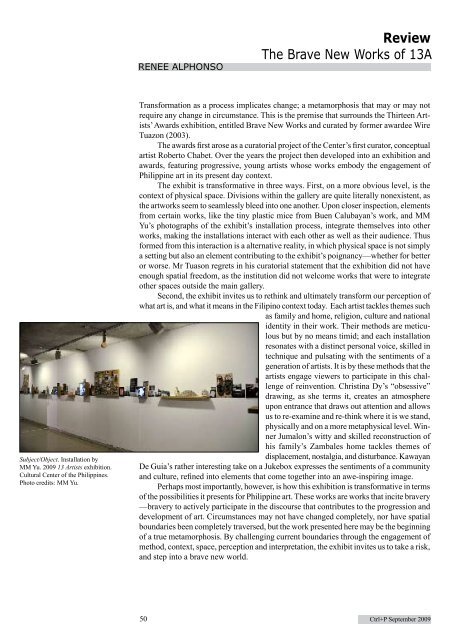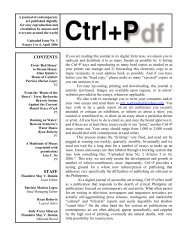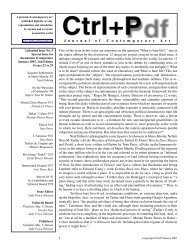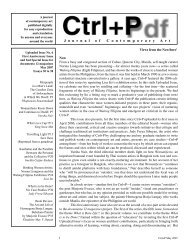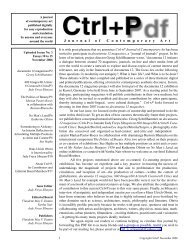Issue 15 - Pdf Ctrl+P - CTRL+P: a journal of contemporary art
Issue 15 - Pdf Ctrl+P - CTRL+P: a journal of contemporary art
Issue 15 - Pdf Ctrl+P - CTRL+P: a journal of contemporary art
You also want an ePaper? Increase the reach of your titles
YUMPU automatically turns print PDFs into web optimized ePapers that Google loves.
enee alphonso<br />
Review<br />
The Brave New Works <strong>of</strong> 13A<br />
Subject/Object. Installation by<br />
MM Yu. 2009 13 Artists exhibition.<br />
Cultural Center <strong>of</strong> the Philippines.<br />
Photo credits: MM Yu.<br />
Transformation as a process implicates change; a metamorphosis that may or may not<br />
require any change in circumstance. This is the premise that surrounds the Thirteen Artists’<br />
Awards exhibition, entitled Brave New Works and curated by former awardee Wire<br />
Tuazon (2003).<br />
The awards first arose as a curatorial project <strong>of</strong> the Center’s first curator, conceptual<br />
<strong>art</strong>ist Roberto Chabet. Over the years the project then developed into an exhibition and<br />
awards, featuring progressive, young <strong>art</strong>ists whose works embody the engagement <strong>of</strong><br />
Philippine <strong>art</strong> in its present day context.<br />
The exhibit is transformative in three ways. First, on a more obvious level, is the<br />
context <strong>of</strong> physical space. Divisions within the gallery are quite literally nonexistent, as<br />
the <strong>art</strong>works seem to seamlessly bleed into one another. Upon closer inspection, elements<br />
from certain works, like the tiny plastic mice from Buen Calubayan’s work, and MM<br />
Yu’s photographs <strong>of</strong> the exhibit’s installation process, integrate themselves into other<br />
works, making the installations interact with each other as well as their audience. Thus<br />
formed from this interaction is a alternative reality, in which physical space is not simply<br />
a setting but also an element contributing to the exhibit’s poignancy—whether for better<br />
or worse. Mr Tuason regrets in his curatorial statement that the exhibition did not have<br />
enough spatial freedom, as the institution did not welcome works that were to integrate<br />
other spaces outside the main gallery.<br />
Second, the exhibit invites us to rethink and ultimately transform our perception <strong>of</strong><br />
what <strong>art</strong> is, and what it means in the Filipino context today. Each <strong>art</strong>ist tackles themes such<br />
as family and home, religion, culture and national<br />
identity in their work. Their methods are meticulous<br />
but by no means timid; and each installation<br />
resonates with a distinct personal voice, skilled in<br />
technique and pulsating with the sentiments <strong>of</strong> a<br />
generation <strong>of</strong> <strong>art</strong>ists. It is by these methods that the<br />
<strong>art</strong>ists engage viewers to p<strong>art</strong>icipate in this challenge<br />
<strong>of</strong> reinvention. Christina Dy’s “obsessive”<br />
drawing, as she terms it, creates an atmosphere<br />
upon entrance that draws out attention and allows<br />
us to re-examine and re-think where it is we stand,<br />
physically and on a more metaphysical level. Winner<br />
Jumalon’s witty and skilled reconstruction <strong>of</strong><br />
his family’s Zambales home tackles themes <strong>of</strong><br />
displacement, nostalgia, and disturbance. Kawayan<br />
De Guia’s rather interesting take on a Jukebox expresses the sentiments <strong>of</strong> a community<br />
and culture, refined into elements that come together into an awe-inspiring image.<br />
Perhaps most importantly, however, is how this exhibition is transformative in terms<br />
<strong>of</strong> the possibilities it presents for Philippine <strong>art</strong>. These works are works that incite bravery<br />
—bravery to actively p<strong>art</strong>icipate in the discourse that contributes to the progression and<br />
development <strong>of</strong> <strong>art</strong>. Circumstances may not have changed completely, nor have spatial<br />
boundaries been completely traversed, but the work presented here may be the beginning<br />
<strong>of</strong> a true metamorphosis. By challenging current boundaries through the engagement <strong>of</strong><br />
method, context, space, perception and interpretation, the exhibit invites us to take a risk,<br />
and step into a brave new world.<br />
50 <strong>Ctrl+P</strong> September 2009


